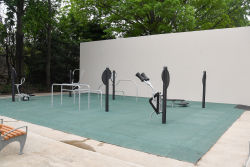Gen. Douglas MacArthur Park
General Douglas Macarthur Park
What was here before?
The land encompassing this park and the General Charles W. Berry Houses was once occupied by the Richmond County Fair Grounds. In 1905 the Richmond County Fair moved to the fairgrounds, after it was previously held in West New Brighton from 1895 to 1904. The new venue featured a grandstand, half-mile track, and 100-foot-long exhibition building specifically designed to host this annual event, which at the turn of the century was touted as the city’s only county fair. It was replete with games, exhibitions, sporting events, and demonstrations. The fair ran until 1926 and was later revived in 1979 at Historic Richmond Town, where it is still held every year.
How did this site become a park?
General Douglas MacArthur Park was developed as part of the General Charles W. Berry Houses public housing project, named after a former Commander of the New York National Guard and City Comptroller. The park opened in April 1951, a year after the completion of the housing complex. In 2020, this project was fully reconstructed, which added a synthetic turf multiuse field, new basketball courts with bleacher seating, chess tables, adult fitness equipment, improved lighting, and more welcoming park edges and entrances.
Who is this park named for?
This park is named for General Douglas MacArthur (1880-1964), an important, if controversial, figure in American military history. MacArthur was born on January 26, 1880 in Little Rock Barracks, Arkansas. After graduating from West Point in 1903, he served as a Second Lieutenant in the United States Army in France during World War I (1914-1918), and in the Philippine Islands and Mexico. In 1930, President Herbert Hoover (1874-1964) appointed MacArthur Chief of Staff of the Army.
MacArthur retired in 1935 but was called back into service when America entered World War II (1939-1945) in 1941. In April 1942, President Franklin Delano Roosevelt (1882-1945) named MacArthur the Supreme Allied Commander in the Pacific. On September 2, 1945, MacArthur accepted the Japanese surrender in Tokyo Bay and became the military governor of occupied Japan (1945-1950). He was later appointed Commander-in-Chief of the United Nations forces during the Korean War (1950-1953). Despite accolades for his bravery and ingenuity, his aggressive approach ultimately led to his dismissal in 1951 by President Harry S. Truman (1888-1972).
MacArthur settled in New York City after retiring from the military again. In 1952, he ran for the Republican Presidential nomination, losing to Dwight D. Eisenhower (1890-1969) but served as an unofficial advisor to Eisenhower and President John F. Kennedy (1917-1963). He died in 1964 and was buried in Norfolk, Virginia.
Check out your park's Vital Signs
Clean & Safe
Green & Resilient
Empowered & Engaged Users
Share your feedback or learn more about how this park is part of a
Vital Park System









